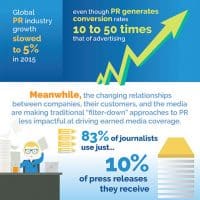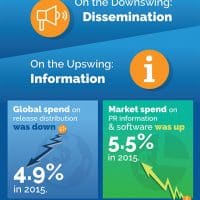How Tech-Driven Media Intelligence Will Fuel the Future of PR

Across industries as varied as finance, e-commerce, and food/beverage, companies today are focused on much more than business as usual: Morgan Stanley is giving career advice to women; Amazon is entering cargo delivery; and Coca-Cola is training entrepreneurs in underprivileged geographies.
It’s increasingly clear that in 2016, businesses of all sizes are thinking about much more than revenue – they’re aiming to change their industries, seize new markets, and foster long-term change. But to make sure the world knows (and cares about) what they’re up to, businesses are relying on the same loudspeaker they’ve always had: The media.
Of course, PR (aka the “persuasion business”) is the vessel that bridges the gap between businesses and the media. Yet troublingly, there’s arguably never been a time when C-suite executives were less eager to allocate their budgets to public relations: Global PR industry growth slowed to 5 percent in 2015 – a significant downshift from double-digit growth just two years earlier.
This isn’t a brand new issue; especially in B2B and enterprise-tech driven sectors, executives often perceive PR as an expensive cost center driven largely by vanity metrics, “fluff” media campaigns, and intangible outcomes disconnected from the business development and sales functions of the organization.
Yet in contrast to decreased spending on PR services, there’s one area where public relations spending is on the uptick: Technology. Total market spend on PR information and software went up 5.5 percent in 2015, reaching USD $2.9B.
The diverging spending dynamics show that for the public relations industry to grow and thrive in coming years, it needs to prove its direct value to businesses in the most tangible ways possible. As the increased tech spending, recent industry consolidation, and other shifts increasingly make clear, the next era of PR will be an era of technologically powered proof, not just persuasion.
A (Somewhat) Tech-Powered Past of PR
Due in part to its reputation as a “who you know” sector, PR is rarely name-checked as a strongly tech-enabled industry. Arguably, however, PR’s beginnings were more tech-driven than those of its sister disciplines advertising and marketing.
The emergence of the wire services in the 1950s made mass dissemination of business news to the media possible, well before marketers and advertisers could enjoy such broad reach. As essentially post offices for press releases, wire services were true loudspeakers from businesses to the media – relied on as fundamental to news dissemination to those on both sides of the distribution model.
The newswire model allowed the trickle-down nature of PR and media relations to become the norm: send news at broad scale, monitor for impressions and resulting earned media coverage, and save the exclusives and embargoes for a company’s top news stories and most highly prized media connections.
For decades, that approach was a highly effective baseline, enabling an entire world of media monitoring solutions, journalist databases, and reporting tools to rise up around that model. For large companies, the natural complement to utilizing large communications teams and high-end newswires was high-end media monitoring: Just as they budgeted heavily for PR, Fortune 1000 businesses often allocated as much as $30K annually to get their media intelligence just right.
Yet while the wire was an important and powerful news-dissemination tool for many years, the changing landscape of media is transforming it into an increasingly antiquated solution. The filter-down approach to media relations is simply less effective now that a reported 83 percent of journalists use just 10 percent of press releases they receive.
As a result, global spend on wire news release distribution is on the decline (down 4.9 percent in 2015) and the wire is becoming increasingly irrelevant to driving earned-media outcomes: No matter how large their comm teams or how bold their “beyond business as usual” messages, companies of all sizes need to leverage more creative tactics – spanning one-to-one pitching, social media engagement, sponsored content, thought leadership strategies, and more – to drive media interest.
That evolution has led some observers to assume that PR – and by extension, media monitoring – is either dead or close to taking its last gasp, but that couldn’t be further from the truth. Today, PR has its DNA in the most important marketing concepts impacting businesses… and amid industry consolidation, ‘earned media tech’ is on the cusp of a shift from being the neglected kid-sister of the SaaS-driven ‘martech’ and ‘adtech’ sectors to becoming a key element to business intelligence (in a scalable, cost-friendly way).
Meeting a Digitally Savvy Future of Media Intelligence
At a macro level, it’s easy to understand why businesses’ interest in PR is declining: The lines between marketing, PR, and digital media are getting so blurry that even leading PR stakeholders are unsure what to call themselves. A recent global survey found that only 27 percent of agency leaders believe that by the year 2020 the term “public relations” will clearly and adequately describe their work.
But even as content marketing, brand strategy, and other disciplines increasingly infiltrate the public relations field, it’s important for industry stakeholders to own the importance of PR, period. Why? Because PR generates conversion rates 10 to 50 times that of advertising conversions.
Because successful PR placements don’t result directly from dollars spent, as with advertising – they only follow validation a brand’s news, message, or insights by members of the media (especially as wire disseminations, and syndicated news releases, decline). Ultimately, the third-party validation of earned media coverage remains the most important vehicle for building mutually beneficial relationships, and trust, between entities and their audiences.
And though PR remains a discipline with separate goals and KPIs than those of the marketing department, the values, objectives, and principles of PR are of the utmost importance to marketing (and business) success in the changing digital landscape: Corporate storytelling and genuine relationship building are key to marketing in 2016, and they’re concepts undoubtedly originated in PR’s world of spin and “driving the narrative.”
Driving that narrative will take solutions that deliver results beyond the traditional capabilities of the wire. In the shakeout of recent industry consolidation, Cision purchased PR Newswire for $841 million – essentially doubling down on its commitment to the wire at a time of declining spending.
But as PR firms and their clients shift toward a greater focus on using media relations to drive ROI and business outcomes, PR success will be driven more by the quality of coverage (and the outcomes of follow-on marketing efforts) than by the quantity of broad, wire-induced impressions – making it highly necessary for the PR industry to have more intelligent targeting and distribution tools to help firms give their clients a better understanding of results.
PR firms looking to build stronger trust with clients are wise to work with vendors that can provide them access to broad global databases, and to use those databases to deliver stronger ROI to their clients than traditional wire releases can realize. Moving forward, the use of robust media contact databases – spanning both traditional journalists and social media influencers – will be more important to driving PR outcomes than broad newswire distributions will.
Following the recent acquisition of Agility from PR Newswire, MediaMiser is one of only a handful of companies able to offer a global media contact dataset and a comprehensive toolset of media intelligence solutions and services for PR organizations of all sizes… and is the only vendor in the earned-media space with no ties to the (increasing irrelevant) wire industry.
Further, to maintain its relevance in today’s digital landscape, PR – much like marketing and advertising – must to prove its impact on the bottom line. The C-suite stakeholders of every PR, marketing, or advertising customer are concerned with the same things: strategic alignment with sales; transparency into overall performance; and metrics and performance indicators that exceed industry benchmarks.
Yet whereas marketing and advertising have benefited from the rises of martech and adtech solutions (and the data they deliver) to prove their value, PR has in many ways struggled to adapt to larger evolutions. Thankfully, that’s starting to change.
With MediaMiser and Agility coming together, the media monitoring space is at a similar inflection point as CRM/Salesforce was in the early 2000s. Just like marketing automation and CRM data, media intelligence data can be a high-value tool for business intelligence and long-term decision making regarding product/market fit, customer engagement, market trends, and more.
With the right media monitoring toolset, it shouldn’t be difficult for the C-suite to see and assess the correlations between PR and concerns such as product sales, customer engagement, website traffic, and more.
And that’s key to PR industry growth: With stronger ROI intel, everyone can perform better and PR’s role across the business can be prioritized. The more that the PR function works with other departments, the more its metrics will show a greater impact on the business and the larger business objectives – and from there, the more successful the PR department can become.
Have you read?
Millennials and the retail revolution
Gender Dilemmas in Tech: Practicing Mindfulness
3 Strategies for Avoiding Google’s Dreaded Blacklists
America’s 22 Best Universities For 2017: Princeton, Harvard, UChicago, And Yale Tops
Written by: Chris Morrison, President, MediaMiser.
Add CEOWORLD magazine to your Google News feed.
Follow CEOWORLD magazine headlines on: Google News, LinkedIn, Twitter, and Facebook.
This report/news/ranking/statistics has been prepared only for general guidance on matters of interest and does not constitute professional advice. You should not act upon the information contained in this publication without obtaining specific professional advice. No representation or warranty (express or implied) is given as to the accuracy or completeness of the information contained in this publication, and, to the extent permitted by law, CEOWORLD magazine does not accept or assume any liability, responsibility or duty of care for any consequences of you or anyone else acting, or refraining to act, in reliance on the information contained in this publication or for any decision based on it.
Copyright 2024 The CEOWORLD magazine. All rights reserved. This material (and any extract from it) must not be copied, redistributed or placed on any website, without CEOWORLD magazine' prior written consent. For media queries, please contact: info@ceoworld.biz
SUBSCRIBE NEWSLETTER














